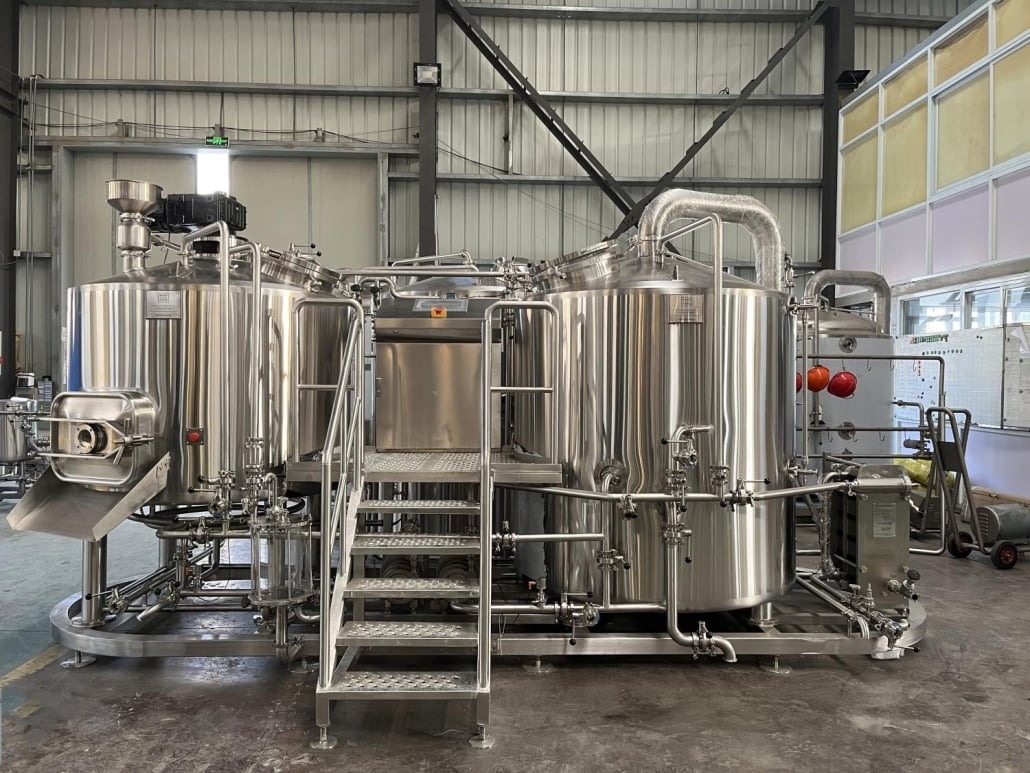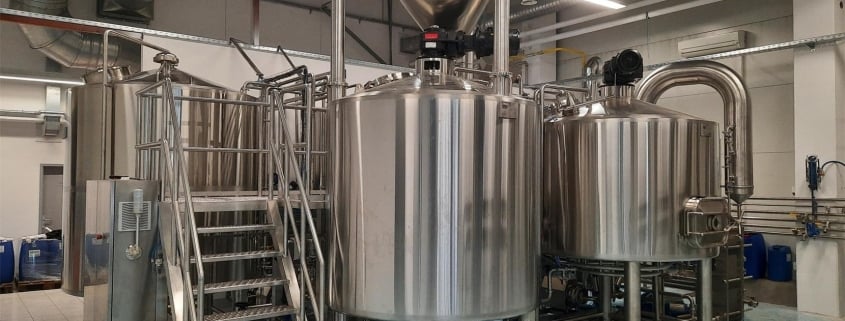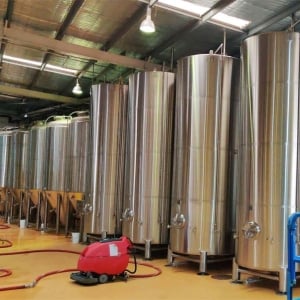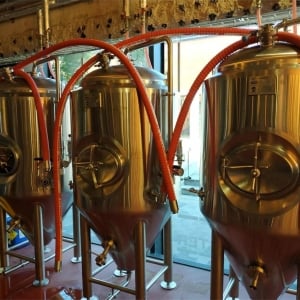Jacketed Fermenters
Imagine this: you’ve meticulously crafted your wort, nurtured it through the vigorous boil, and pitched your precious yeast. Now comes the crucial fermentation stage, where temperature plays a starring role. This is where jacketed fermenters take center stage, offering unparalleled precision temperature control for brewers seeking to unlock the full potential of their creations.
What is a Jacketed Fermenter?
A jacketed fermenter is a stainless steel vessel equipped with a double wall. The space between these walls, called the jacket, acts as a channel for a coolant, typically glycol. By circulating chilled glycol through the jacket, a jacketed fermenter allows brewers to precisely regulate the fermentation temperature of their wort, ensuring optimal conditions for specific yeast strains and beer styles.
Features of Jacketed Fermenters
- Precise Temperature Control: The magic lies in the jacket. By circulating cool glycol, brewers can maintain consistent and accurate fermentation temperatures, crucial for promoting healthy yeast activity and achieving desired flavor profiles.
- Conical Bottom Design: Jacketed fermenters often boast a conical bottom, resembling an inverted cone. This design facilitates the collection of sediment (yeast trub) at the lowest point, enabling easier separation from the clarified beer during racking (transferring the beer to another vessel).
- Increased Efficiency: Precise temperature control allows for faster and more predictable fermentation cycles. This translates to quicker turnaround times and potentially higher production volumes for commercial breweries.
- Improved Beer Quality: Consistent temperatures minimize stress on yeast, leading to cleaner fermentations and beers with fewer off-flavors. Additionally, temperature control allows brewers to explore a wider range of yeast strains and beer styles, pushing the boundaries of creativity.
- Versatility: Jacketed fermenters are not limited to beer production. They can be used for fermenting wine, cider, kombucha, and other beverages where temperature control is critical.

Types of Jacketed Fermenters
Jacketed fermenters come in various sizes and configurations to suit the needs of different brewers. Here’s a breakdown of some common types:
| Jacketed Fermenter Type | Description | Ideal For |
|---|---|---|
| Unitanks | These versatile vessels combine fermentation and conditioning functionalities within a single tank. They feature a jacket for temperature control and a bottom outlet for yeast collection. | Breweries seeking space optimization and streamlined workflows. |
| Top-Mount Jacketed Fermenters | The fermenter vessel sits on a separate stand, with the glycol jacket surrounding the main body. | Breweries with limited headspace or those requiring easier access to the fermenter during the process. |
| Bottom-Jacketed Fermenters | The jacket encompasses the lower portion of the fermenter, offering a more cost-effective solution for temperature control. | Cost-conscious brewers who prioritize temperature management in the critical early stages of fermentation. |
The Brewing Process with Jacketed Fermenters
While the core brewing process remains consistent, jacketed fermenters elevate temperature control to a whole new level:
- Wort Preparation: The wort (unfermented beer) is brewed according to your chosen recipe.
- Transfer to Jacketed Fermenter: The cooled wort is transferred to the sanitized jacketed fermenter.
- Yeast Pitching: The appropriate yeast strain is introduced into the wort at the optimal temperature range.
- Temperature Control: The glycol chiller circulates cool glycol through the fermenter jacket, maintaining the desired temperature throughout fermentation.
- Primary Fermentation: The yeast actively consumes sugars in the wort, converting them into alcohol and carbon dioxide. The jacketed fermenter ensures consistent temperatures for optimal yeast activity.
- Secondary Fermentation (Optional): Some styles may undergo a secondary fermentation at a cooler temperature to promote further conditioning and flavor development. The jacketed fermenter again facilitates precise temperature control.
- Packaging: Once fermentation is complete, the beer is clarified, filtered, and packaged for consumption or further conditioning.
Capacity, Space Requirements, Design & Layout, Customization
Jacketed fermenters come in a wide range of capacities, from compact homebrew-sized vessels to large-scale units used by commercial breweries. Here’s a table outlining key considerations:
| Factor | Description | Considerations |
|---|---|---|
| Capacity | Ranges from a few gallons for homebrewers to hundreds or even thousands of gallons for commercial operations. | Select a capacity that aligns with your production volume and batch sizes. |
| Space Requirements | The footprint of a jacketed fermenter depends on its size and configuration. Consider additional space for hoses, glycol chillers (if not integrated), and cleaning equipment. | Plan your brewery layout to accommodate the fermenters and ancillary equipment. |
| Design & Layout | Jacketed fermenters can be freestanding units or integrated into a brewery’s existing infrastructure. Some manufacturers offer modular systems that allow for customization and expansion. | Choose a design that fits your space constraints and production workflow. |
| Customization | Many manufacturers offer customization options, such as adding ports for instrumentation, sampling valves, and dry hopping ports. | Consider customizations that enhance your brewing process and meet your specific needs. |
Jacketed Fermenter Suppliers and Price Range
The cost of a jacketed fermenter varies depending on factors like size, features, and brand. Here’s a table providing a general price range:
| Jacketed Fermenter Capacity | Price Range (USD) |
|---|---|
| Homebrew (5-15 gallons) | $800 – $3,500 |
| Pilot Systems (20-50 gallons) | $4,000 – $10,000 |
| Microbrewery Systems (100-500 gallons) | $15,000 – $50,000 |
| Commercial Breweries (1,000+ gallons) | $50,000+ |
Installation, Operation, and Maintenance
Proper installation, operation, and maintenance are crucial for maximizing the performance and lifespan of your jacketed fermenter. Here’s a breakdown of these key aspects:
| Stage | Description | Key Points |
|---|---|---|
| Installation | It’s recommended to have qualified professionals install your jacketed fermenter, ensuring proper placement, connection to glycol chiller systems (if not self-contained), and verification of functionality. | Refer to the manufacturer’s instructions for specific installation guidelines. |
| Operation | Operating a jacketed fermenter involves monitoring and adjusting the fermentation temperature using the chiller system. Some jacketed fermenters come equipped with automated temperature control systems for added convenience. | Familiarize yourself with the controls and functionalities of your specific jacketed fermenter model. |
| Maintenance | Regular cleaning and sanitation are essential to prevent contamination and maintain optimal performance. Follow the manufacturer’s cleaning procedures for your jacketed fermenter, which typically involve using specialized cleaning solutions and thorough rinsing. | Perform preventative maintenance tasks as recommended by the manufacturer to ensure the smooth operation of your jacketed fermenter. |
Choosing the Right Jacketed Fermenter Supplier
Selecting the right jacketed fermenter supplier involves careful consideration of several factors:
| Factor | Description | Importance |
|---|---|---|
| Reputation | Research the supplier’s reputation for quality, reliability, and customer service. | Look for positive reviews and testimonials from other brewers. |
| Experience | Choose a supplier with experience in designing and manufacturing jacketed fermenters. | Experience translates to expertise in ensuring your fermenter meets your needs. |
| Product Range | Does the supplier offer a variety of jacketed fermenter sizes and configurations to suit your brewing needs? | Consider scalability if you plan to expand your brewing operation in the future. |
| Warranty & Support | A strong warranty and reliable after-sales support are crucial for peace of mind. | Ensure the warranty covers parts and labor for a reasonable period. |
| Price | While cost is a factor, prioritize quality and features over the cheapest option. | A reliable jacketed fermenter is an investment that will pay off in the long run. |
Jacketed Fermenters: Pros and Cons
Pros
- Precise Temperature Control: The biggest advantage of jacketed fermenters is their ability to maintain consistent and accurate fermentation temperatures, leading to superior beer quality.
- Improved Efficiency: Precise temperature control optimizes fermentation processes, potentially reducing fermentation times and increasing production throughput.
- Versatility: Jacketed fermenters can be used for various fermentation applications beyond beer, making them a valuable asset for multi-product breweries.
- Increased Consistency: By controlling a critical factor like temperature, jacketed fermenters help brewers achieve consistent results from batch to batch.
- Enhanced Scalability: Jacketed fermenters come in various sizes, allowing brewers to scale their operations as their production needs grow.
Cons
- Higher Cost: Jacketed fermenters are a significant investment compared to unjacketed counterparts.
- Increased Complexity: Operating jacketed fermenters requires a basic understanding of temperature control systems, potentially adding a learning curve for new brewers.
- Space Requirements: Jacketed fermenters have a larger footprint due to the double wall construction and potential need for additional glycol chiller equipment.
- Maintenance Needs: Regular cleaning and sanitation are essential for jacketed fermenters to maintain optimal performance, requiring additional time and effort compared to simpler fermentation vessels.
Making an Informed Decision
Ultimately, the decision of whether a jacketed fermenter is right for you depends on your brewing goals, budget, and space constraints. Here are some additional factors to consider:
- Your Brewing Experience: For homebrewers starting out, a simpler, unjacketed fermenter might suffice. However, for those seeking more precise control and aiming for professional-quality results, a jacketed fermenter can be a worthwhile investment.
- Batch Sizes: If you brew large batches regularly, a jacketed fermenter becomes more practical for maintaining consistent temperatures throughout the larger volume of wort.
- Desired Beer Styles: Certain beer styles, particularly those requiring strict fermentation temperature control (like lagers), benefit significantly from the precision offered by jacketed fermenters.

FAQs
Q: Can I use a glycol chiller with a non-jacketed fermenter?
A: Technically, yes. You can improvise cooling methods like wrapping the fermenter with a cold water jacket or using immersion coils. However, these methods are less efficient and offer less precise temperature control compared to a true jacketed fermenter.
Q: How often should I clean my jacketed fermenter?
A: Cleaning frequency depends on how often you use your fermenter. After each use, a thorough sanitation routine is recommended to prevent contamination. Additionally, periodic deep cleaning might be necessary depending on the manufacturer’s instructions and your brewing practices.
Q: What are some reputable jacketed fermenter suppliers?
A: Several reputable suppliers offer jacketed fermenters, including companies like MoreBeer!, OakStills, USA Lab Equipment, and Glacier Tanks. Conduct your research to compare features, capacities, and pricing before making a purchase decision.
Conclusion
Jacketed fermenters empower brewers with the ability to achieve superior temperature control during fermentation. This translates to a multitude of benefits, including improved beer quality, increased efficiency, and enhanced consistency. While the initial investment might be higher compared to unjacketed counterparts, the long-term advantages make jacketed fermenters a compelling choice for serious brewers seeking to elevate their craft. By carefully considering your brewing needs, budget, and space limitations, you can determine if a jacketed fermenter is the key to unlocking the full potential of your brews.















